Carpet plants are a great way to add beauty, texture and color to your tank while providing beneficial hiding places for fish. In this article, I’m going to share some of my top picks for the best aquarium carpet plants for beginners and experts alike.
Carpet plants can offer so many benefits when it comes to aquascaping: they make tanks look more natural, increase oxygen levels, provide shelter and security for shy inhabitants, reduce stress on fish by creating shaded areas with dimmer lighting, and help control algae growth.
No matter what stage you’re at with your setup—beginner or expert—there’s sure to be something here that appeals to you. Let’s get started!
Contents
- 1 Best Aquarium Carpet Plants
- 1.1 Micranthemum ‘Monte Carlo’
- 1.2 Dwarf Hairgrass
- 1.3 Dwarf Baby Tears (Hemianthus callitrichoides ‘Cuba’)
- 1.4 Dwarf Sagittaria
- 1.5 Java Moss
- 1.6 Christmas Moss
- 1.7 Elatine hydropiper
- 1.8 Four Leaf Clover
- 1.9 Micro Sword (Lilaeopsis brasiliensis)
- 1.10 Glossostigma (Glossostigma elatinoides)
- 1.11 Anubias nana Petite
- 1.12 Staurogyne repens
- 1.13 Pygmy Chain Swords
- 1.14 Helanthium tenellum
- 1.15 Marsilea hirsuta
- 1.16 Brazilian Micro Sword
- 2 How To Grow Aquarium Carpet Plants
- 3 Benefits Of Growing Carpet Plants
- 4 Why Carpet Plants Are Harder To Grow
- 5 How To Select Carpet Plants That Are Beginner-Friendly
- 6 Aquarium Carpet Plants FAQs
- 7 Conclusion
Best Aquarium Carpet Plants
Micranthemum ‘Monte Carlo’

This is a popular and versatile carpet plant known for its small, round leaves and bright green color. It can grow in a variety of aquarium conditions and is an excellent choice for creating a lush, green carpet effect.
Dwarf Hairgrass
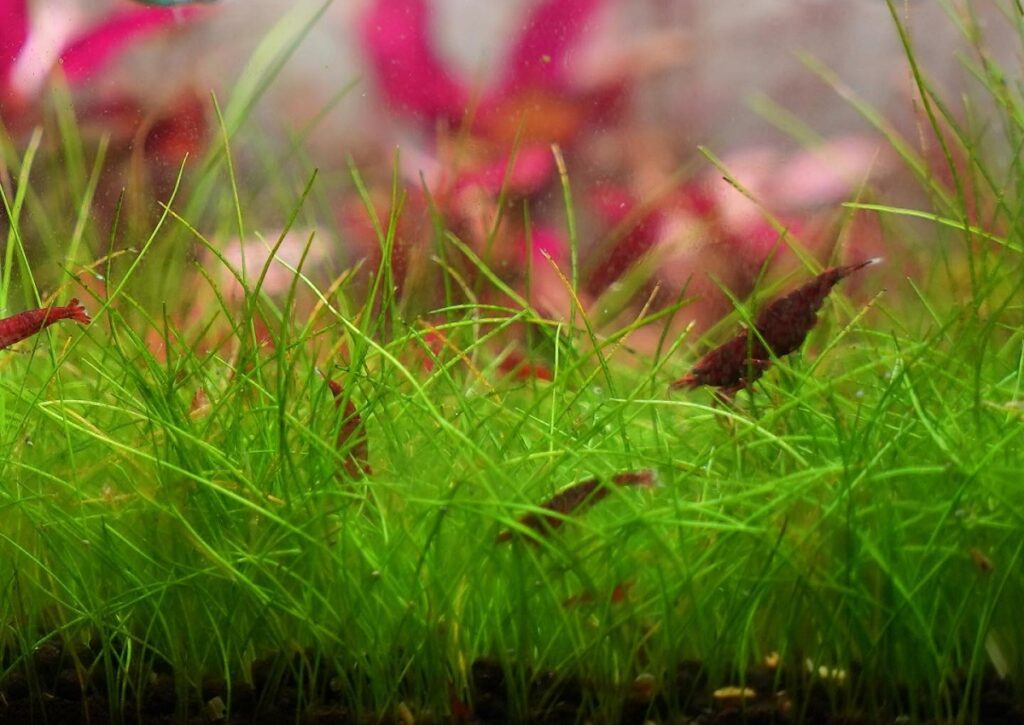
As its name suggests, this carpet plant resembles grass and can create a beautiful underwater meadow. It requires moderate to high light and prefers a nutrient-rich substrate.
Dwarf Baby Tears (Hemianthus callitrichoides ‘Cuba’)
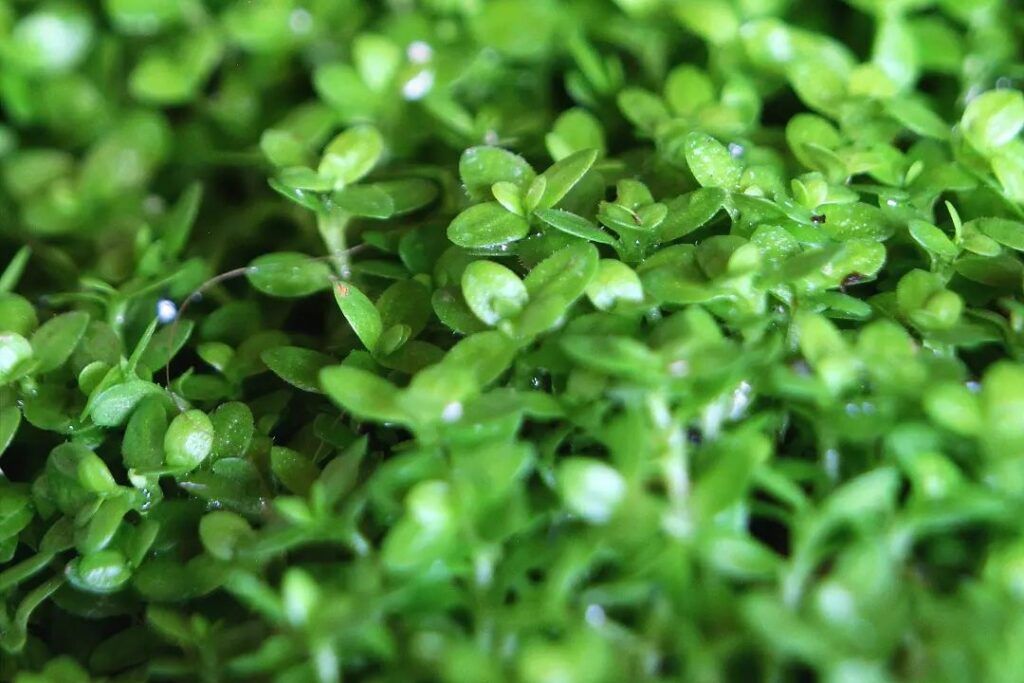
Known for its tiny, teardrop-shaped leaves, this carpet plant creates a dense, lush green carpet in the aquarium. It requires high light and carbon dioxide supplementation to thrive.
Dwarf Sagittaria
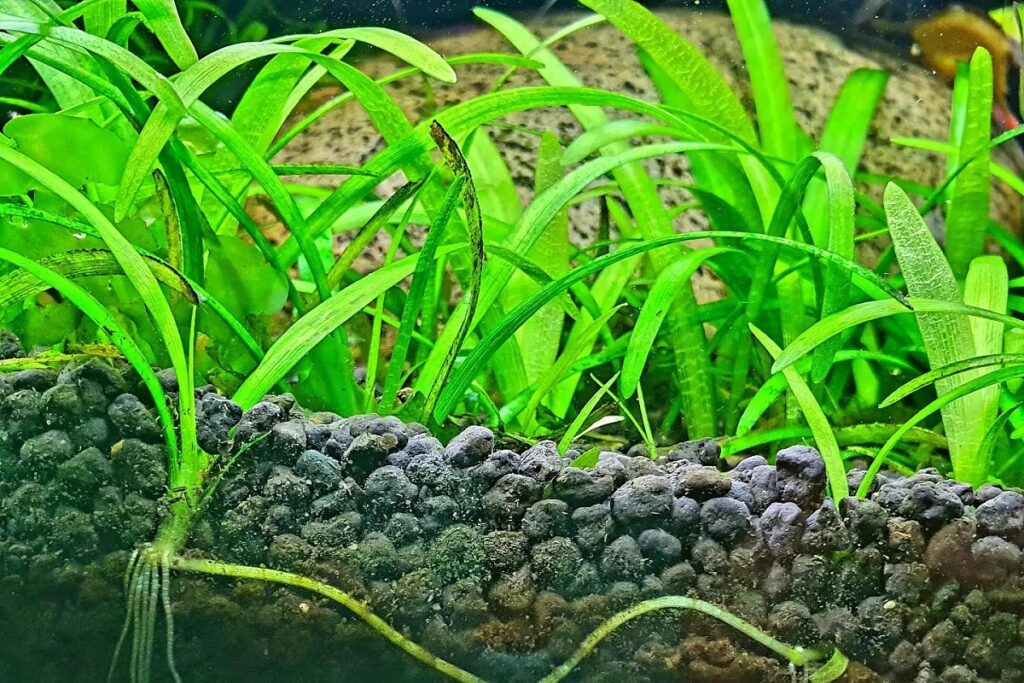
This is an easy-to-grow carpet plant with long, narrow leaves. It can tolerate a range of lighting conditions and will spread rapidly under the right conditions.
Java Moss
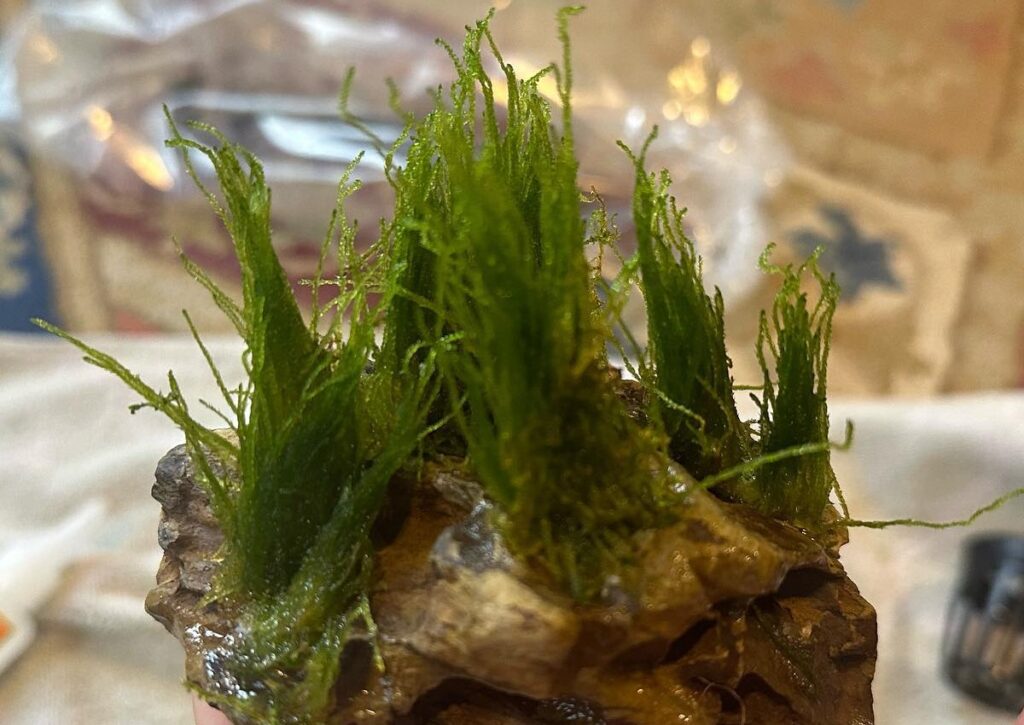
A popular and versatile aquarium plant, Java moss can be used to create a carpet effect by attaching it to rocks or driftwood. It is low-maintenance and can thrive in a range of lighting and water conditions.
Christmas Moss
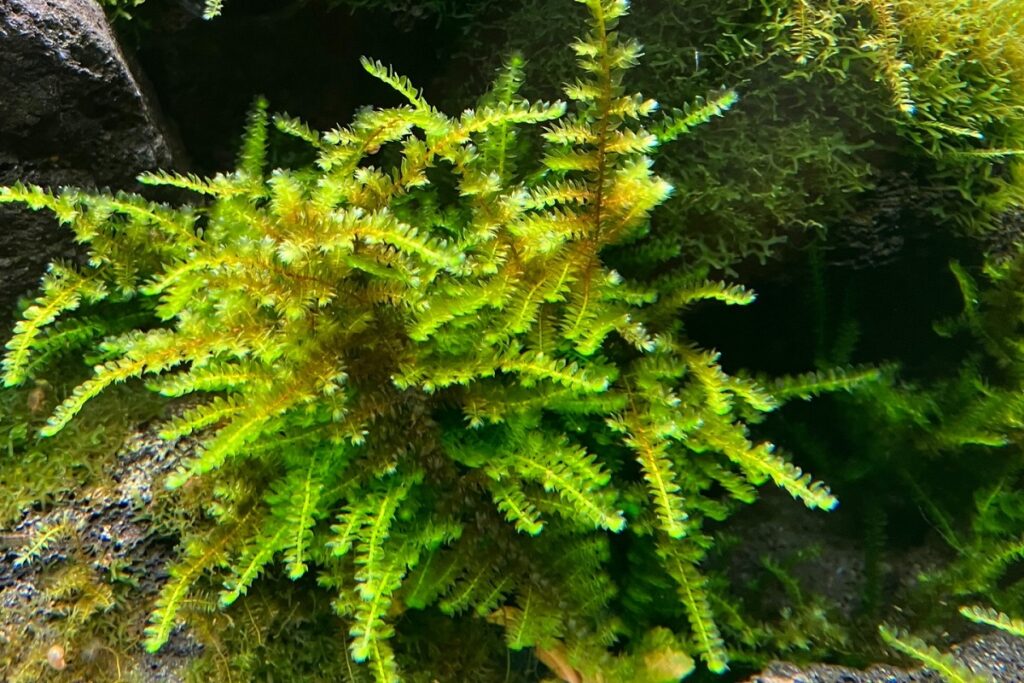
Similar to Java moss, this plant has a unique branching pattern that resembles a Christmas tree. It can be used as a carpet plant by attaching it to surfaces and can grow in a variety of lighting conditions.
Elatine hydropiper
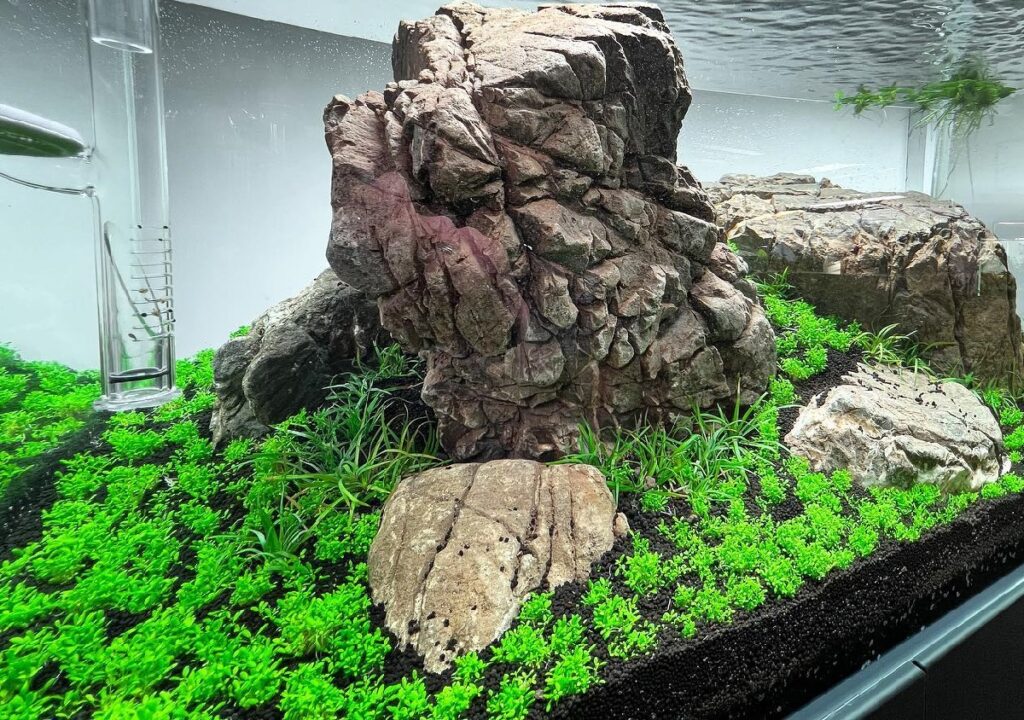
This is a small, delicate carpet plant that forms dense mats of tiny green leaves. It requires high light and nutrient-rich substrate to thrive.
Four Leaf Clover
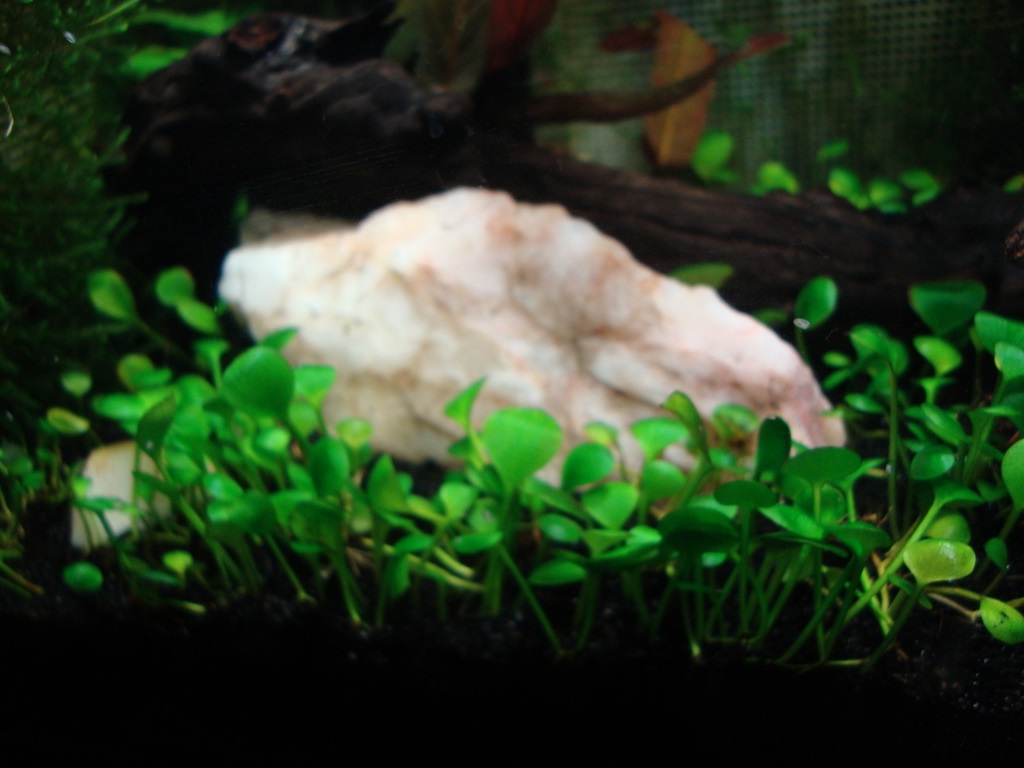
This plant, also known as Marsilea quadrifolia, features clover-like leaves and can create a unique carpet effect. It is relatively easy to grow and can adapt to various lighting conditions.
Micro Sword (Lilaeopsis brasiliensis)

This carpet plant has narrow, grass-like leaves and spreads through runners, creating a dense carpet. It requires moderate to high light and nutrient-rich substrate.
Glossostigma (Glossostigma elatinoides)

This is a fast-growing carpet plant with small, oval leaves. It requires high light and carbon dioxide supplementation for optimal growth.
Anubias nana Petite

Although not a carpet plant in the traditional sense, this small Anubias species can be used to create a low-growing, textured effect in the foreground of an aquarium.
Staurogyne repens
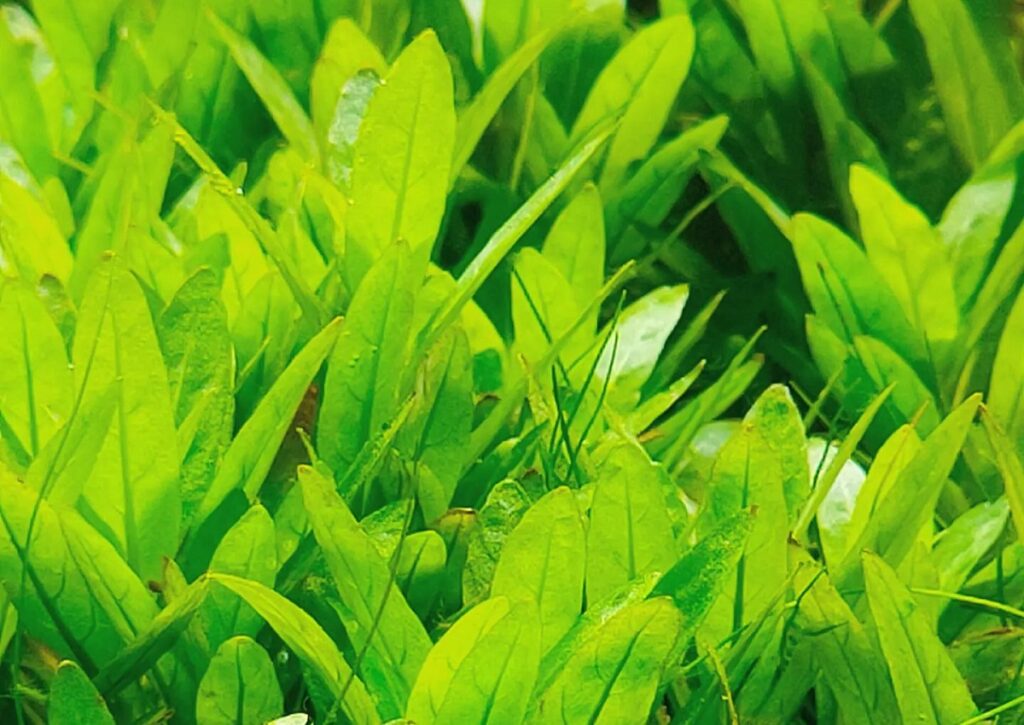
This plant has attractive, dark green leaves and forms a dense carpet when planted closely together. It requires moderate lighting and nutrient-rich substrate.
Pygmy Chain Swords
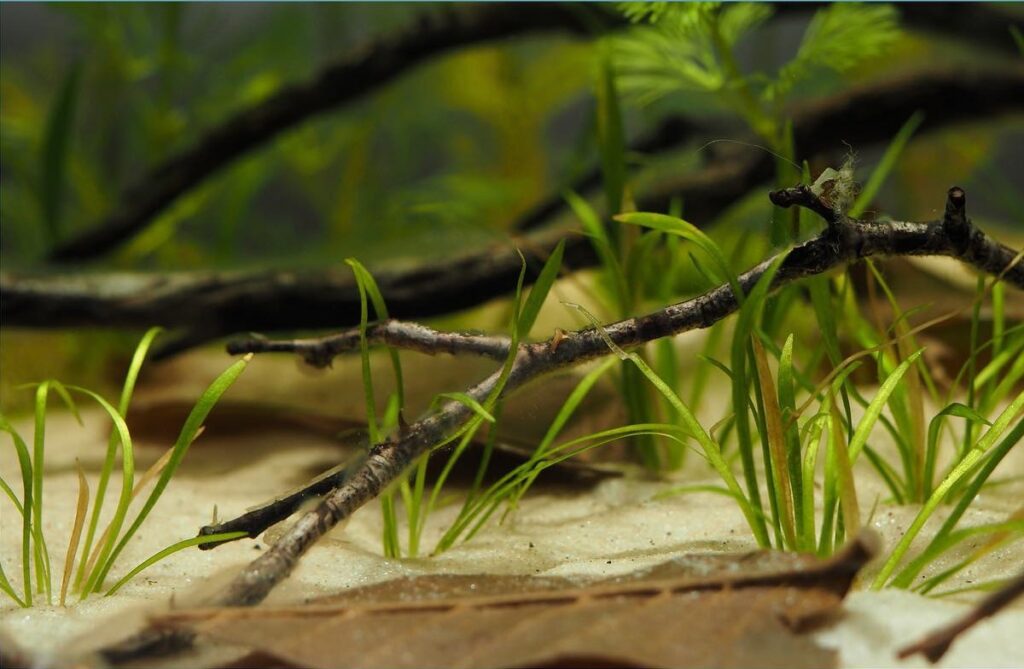
Also known as Echinodorus tenellus, this plant has long, narrow leaves and spreads through runners. It can tolerate a range of lighting conditions and is relatively easy to grow.
Helanthium tenellum
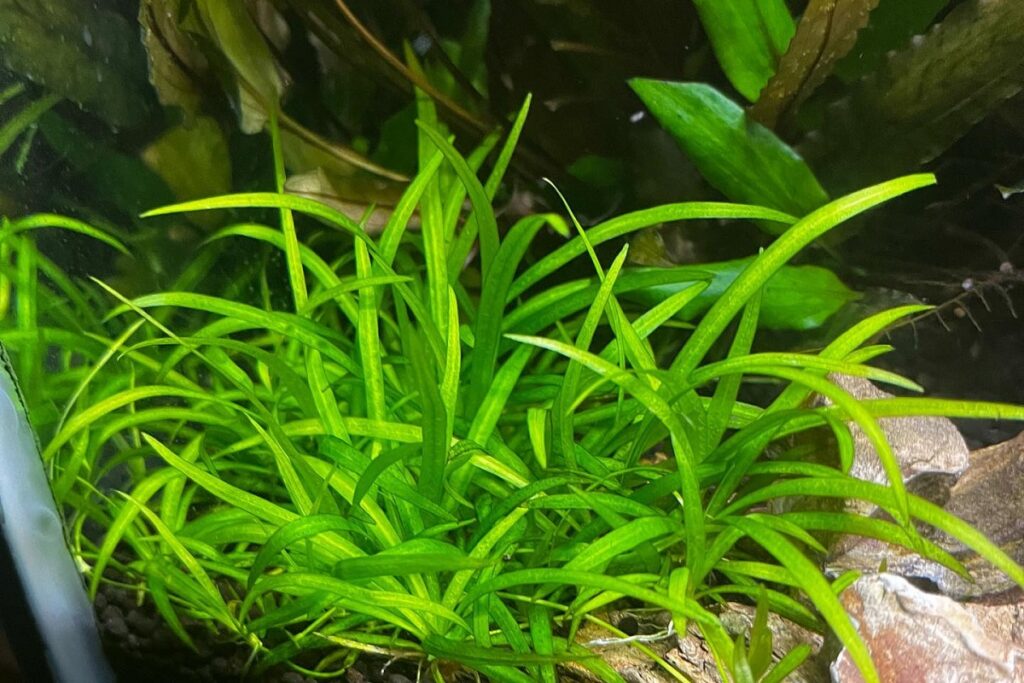
This carpet plant, also known as dwarf chain sword, has thin, grass-like leaves and is easy to grow. It can tolerate a range of lighting conditions and will spread rapidly in the aquarium.
Marsilea hirsuta

This plant has clover-like leaves that can vary in shape depending on lighting conditions. It is relatively easy to grow and can create an interesting carpet effect.
Brazilian Micro Sword
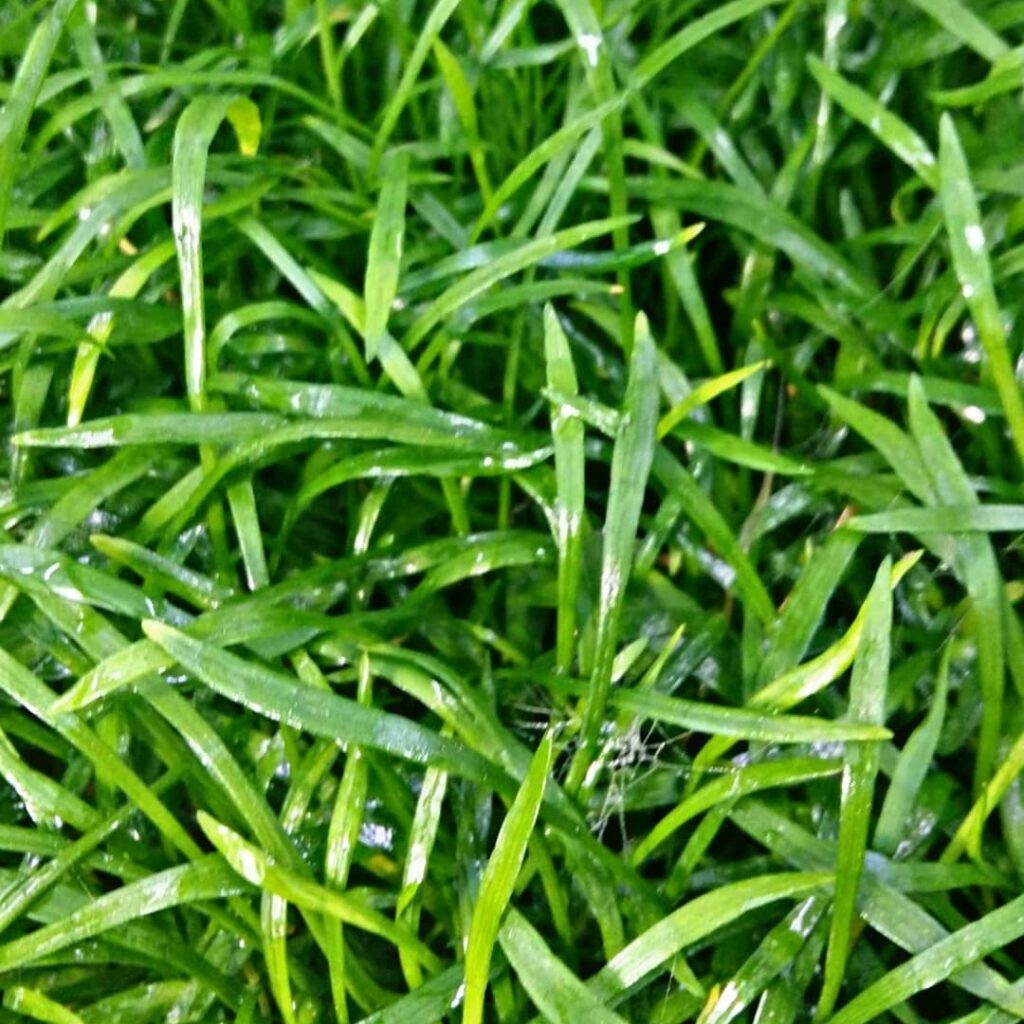
Also known as Lilaeopsis Novae-Zelandiae, this carpet plant has grass-like leaves and creates a dense, mat-like effect in the aquarium. It requires moderate to high light and nutrient-rich substrate for optimal growth.
How To Grow Aquarium Carpet Plants
Growing aquarium carpet plants can be a rewarding experience for both beginners and experts alike. The key to success is understanding the right conditions needed for your chosen plant species, such as water temperature, light requirements, fertilizers, substrate choice and CO2 levels.
First of all, it’s important to understand that different plants require different temperatures; some prefer cool waters while others may thrive in warmer settings.
It’s also essential to choose the right lighting system depending on which type of aquatic vegetation you choose—low-light plants will not do well with bright lights.
Fertilizers are an absolute must in order to provide enough nutrient content for the plants’ growth; make sure to select one specifically formulated for aquaria.
Different substrates have their own properties too so picking the correct one is necessary for certain types of aquarium carpeting.
Finally, adequate carbon dioxide levels should be monitored in order to ensure healthy growth rates for any aquatic vegetation you decide upon.
When done correctly, growing aquarium carpet plants can truly transform your tank into a lush paradise! With careful consideration given to each individual element involved—from selecting the appropriate species suited to your environment and style preferences to ensuring optimal water parameters—there really isn’t anything more enjoyable than seeing your hard work come together over time and watching how vibrant your underwater world can become!
Benefits Of Growing Carpet Plants
Growing carpet plants can be incredibly rewarding for both beginners and experts alike. Not only do these aquatic beauties help to keep the water parameters balanced, but they also provide an interesting visual element that’s sure to delight any fish-keeper! Plus, with all of the various lighting requirements, flooring options, and fertilizing needs available, there are plenty of ways to make your aquarium unique.
Let’s take a look at some of the benefits that come from growing carpet plants:
- Improve Water Quality: Carpet plants act as natural filters by taking in nitrate and keeping ammonia levels down. This helps create a healthier environment for your fish.
- Add Beauty to Your Tank: With so many different varieties of carpet plants available, you can find one that fits your style and makes your aquarium stand out.
- Low Light Options: For those who feel intimidated by high light requirements, you’ll be happy to know that there are several low light species available such as Java Moss or Dwarf Baby Tears.
- High Light Options: If bright lights don’t scare you away then consider adding more colorful species like Rotala Rotundifolia or Ludwigia Repens which will really bring life into your tank.
- Floating Species: Did you know that some species of carpet plants grow on the surface? These types add texture while helping reduce algae growth due to shading out sunlight.
- Fish Compatibility: Many types of fish love swimming around carpets because it provides them with shelter and protection when needed. As long as enough space is provided there should be no issues between fish compatibility and having a carpeted aquarium.
Carpet plants offer an abundance of benefits for both beginner and expert aquarists alike; from improved water quality to providing a safe haven for fish, there is something here for everyone no matter what their skill level may be!
Why Carpet Plants Are Harder To Grow
Growing carpet plants can be a bit challenging, especially for beginners. One of the most important factors to consider is managing water parameters. Water hardness and pH levels need to be monitored carefully in order to ensure the health of aquatic life.
Substrate choice also plays an important role in cultivating healthy aquarium carpets, as it provides essential nutrients to the plant’s root system and helps with anchoring them into place. Light intensity must also factor into your considerations; some species may require more light than others.
Fertilization methods, such as liquid fertilizers or substrate tablets, are also needed when growing aquarium carpets. Planting techniques should also not be overlooked – certain carpet plants may require special arrangements depending on their growth pattern and size.
Ultimately, all these elements work together in creating a successful environment for the aquatic life that you wish to cultivate and maintain. Therefore, we can see why it requires dedication and patience for both beginner aquarists and experts alike when attempting to grow carpet plants successfully!
How To Select Carpet Plants That Are Beginner-Friendly
Carpet plants can be a great addition to any aquarium, but they do tend to require more work than many other types of aquarium plants. While that may sound intimidating, it doesn’t have to be! With the right tools and information, even beginners can successfully maintain carpet plants in their tanks.
When selecting carpeting for beginner-friendly success, here are three key elements you should consider:
- Light Requirements: Carpeting requires higher lighting levels than some other aquatic plants; so make sure your tank is equipped with appropriate bulbs or LED lights.
- Water Parameters: Make sure your water parameters like pH, hardness and temperature match what’s required by the particular type of plant you choose.
- Planting Techniques and Substrate Needs: Different types of carpet plants will need different substrates (e.g., sand or gravel). Be aware of this when picking out your substrate and planting technique as well as making sure all decorations don’t interfere with proper growth conditions.
With these tips in mind, even a novice aquarist can select carpeting perfect for them and their tank setup! All you need is just a bit of research into the species you’re interested in to ensure successful maintenance over time.
Aquarium Carpet Plants FAQs
What are the fastest-growing carpet aquarium plants?
One of the fastest-growing carpet aquarium plants is Dwarf Hairgrass (Eleocharis Parvula). This plant is native to North America and is known for its ability to quickly spread across an aquarium’s substrate, creating a lush and dense carpet. Its grass-like appearance makes it an attractive option for aquascapers who want to create a natural-looking environment for their fish and invertebrates. Dwarf Hairgrass is a versatile plant that can thrive in various aquarium conditions, including low to medium light and different water parameters. However, it grows best when provided with CO2 supplementation and nutrient-rich substrate.
Another fast-growing carpet plant is the Marsilea Hirsuta. This plant originates from Australia and is characterized by its small, clover-like leaves. Marsilea Hirsuta can adapt to a wide range of aquarium conditions and lighting, making it a popular choice for beginners and experienced aquarists alike. This plant’s growth rate increases significantly when exposed to intense lighting and provided with CO2 supplementation. As it spreads, Marsilea Hirsuta forms a dense, lush carpet that provides an excellent hiding place for small fish and invertebrates while also enhancing the overall aesthetic appeal of the aquarium.
These two plants, Dwarf Hairgrass and Marsilea Hirsuta, are excellent options for aquarists looking to create a stunning carpet effect in their aquarium quickly.
Do you need CO2 for carpet plants?
CO2 is not absolutely necessary for carpet plants, but it can significantly enhance their growth and overall health.
Carbon dioxide (CO2) is one of the essential building blocks for plant growth, as it is a crucial component of photosynthesis. Although carpet plants can survive without supplemental CO2, they will grow much slower and may not achieve the dense, lush appearance that aquarium hobbyists desire.
Providing additional CO2 can boost growth rates, improve coloration, and promote a healthier root system, which in turn leads to a more stable and vibrant aquatic environment. Many hobbyists use CO2 injection systems to maintain a consistent level of CO2 in the water, which can be particularly beneficial for more demanding carpet plant species.
It is important to note, however, that adding CO2 to an aquarium requires careful monitoring and adjustments to ensure that water parameters remain stable and suitable for the tank’s inhabitants.
What are the best carpet plants for aquariums without CO2?
The best carpet plants for aquariums without CO2 are those that can thrive in low-tech environments and do not require heavy fertilization or intense lighting. Some popular options include:
- Dwarf Sagittaria (Sagittaria subulata): This hardy, fast-growing plant is ideal for beginners and can form a lush green carpet in the foreground of an aquarium. It can grow in various lighting conditions and does not require CO2 supplementation. However, it may grow taller in low-light settings.
- Marsilea hirsuta: This small, clover-like plant is relatively undemanding and can grow well in low-to-moderate light environments without CO2 supplementation. It may take some time to establish a dense carpet, but its unique appearance makes it a popular choice for aquascapers.
- Cryptocoryne parva: This slow-growing, low-light tolerant plant can form a dense carpet when given enough time. It does not require CO2 supplementation and can thrive in a variety of water conditions. However, it may require occasional fertilization to maintain its growth.
- Java Moss (Taxiphyllum barbieri): Although not a typical carpeting plant, Java Moss can be attached to rocks or driftwood to create a lush, green carpet. It is a hardy plant that can tolerate low light and does not require CO2 supplementation.
- Staurogyne repens: This low-growing plant can create a dense carpet in the foreground of an aquarium without requiring CO2 supplementation. It can grow under low-to-moderate lighting, and it is relatively easy to maintain.
By choosing one or more of these carpet plants for your aquarium, you can create a visually appealing environment for your aquatic inhabitants without relying on CO2 supplementation. Keep in mind that while these plants can thrive without CO2, providing adequate lighting and occasional fertilization will help them grow faster and healthier.
What is the easiest carpet plant to grow?
One of the easiest carpet plants to grow is the Marsilea hirsuta. This low-maintenance plant is an excellent choice for beginners who want to create a lush, green carpet in their aquarium or terrarium. It is also known as “dwarf four leaf clover” due to its small clover-like leaves, which make it an attractive addition to any aquatic environment.
Marsilea hirsuta is a versatile plant that can adapt to a wide range of water conditions, making it suitable for various types of aquarium setups. It grows well in low to medium light and does not require CO2 supplementation, although it will grow faster with CO2 addition. The plant spreads through runners, which form a dense network of interconnected plants, creating a thick carpet over the substrate.
It is important to provide a nutrient-rich substrate to support its growth, and it will benefit from the occasional addition of liquid fertilizers. Overall, Marsilea hirsuta is an excellent choice for hobbyists looking for an easy-to-grow carpet plant that will create a beautiful and natural-looking aquatic landscape.
What is the best soil for aquarium carpets?
The best soil for aquarium carpets is a nutrient-rich substrate specifically designed for aquatic plants. This type of substrate is often composed of fine granules that promote root growth and allow for easy planting of carpeting plants. These substrates usually contain essential nutrients and minerals, such as iron, potassium, and nitrogen, which are crucial for the healthy growth and development of aquatic plants. Moreover, they have a porous structure that allows beneficial bacteria to thrive, improving the overall water quality in the aquarium.
One popular choice for aquarium carpets is aqua soil, which is made from natural volcanic ash and other organic materials. Aqua soil provides the ideal environment for carpeting plants, as it lowers the pH and softens the water, making it more suitable for most aquatic plants. Additionally, aqua soil contains a high concentration of nutrients, ensuring that plants receive the nourishment they need to grow and spread across the aquarium floor.
Another option is using a combination of substrates, such as layering aqua soil with a layer of a nutrient-rich substrate like laterite or fluorite. This not only provides the necessary nutrients for plant growth but also enhances the overall aesthetics of the aquarium.
Ultimately, the choice of soil will depend on the specific plants being used and your preferences, but a nutrient-rich substrate designed for aquatic plants is essential for successful aquarium carpeting.
Conclusion
Growing aquarium carpet plants is an enjoyable and rewarding experience for both beginners and experts.
Carpet plants are great for adding texture, color, and life to your tank, but they do require more attention than other types of aquatic plants.
With a little bit of patience and a careful selection of beginner-friendly species, you can easily create the perfect underwater oasis filled with lush carpets of green!
So why not give it a try? You’ll be glad you did!
